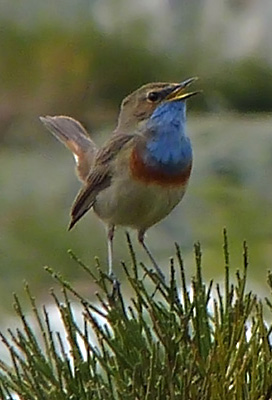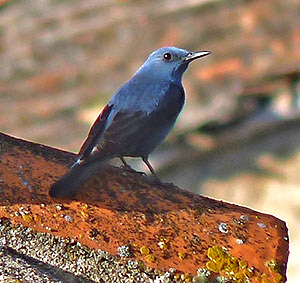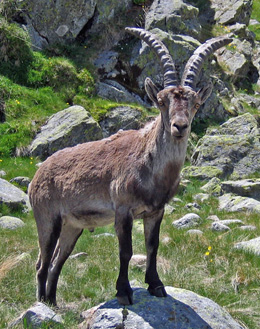Discover the wildlife of Extremadura with John Muddeman, author of the acclaimed A Birdwatching Guide to Extremadura and Accredited Wildlife Guide to this remarkable region!
Colourful European Bee-eaters and European Rollers hawk from wires, majestic Great Bustards strut the plains and huge skies are thronged with dozens of raptors, including the enormous Eurasian Black Vulture. A seemingly low wall of mountains stretches across the background forming a superb backdrop and provides home to showy Bluethroats and Rufous-tailed Rock Thrushes, discrete Ortolan Buntings and tinkling groups of Citril Finches. These are just some of the delights we aim to experience on this tour, as we explore the wealth of wildlife of the plains and mountains of Extremadura and the Sierra de Gredos, in this somewhat forgotten corner of Europe.  European Bee-eaters Merops apiaster
© John Muddeman
European Bee-eaters Merops apiaster
© John Muddeman
But the birds are only an excellent excuse to come and visit Extremadura, a land of vast ancient estates and rolling terrain containing some of the best steppe, woodland and mountain habitats in inland Spain. Over 75% of this vast region qualifies under Internationally Important Bird Area criteria, so it is no surprise that the superlatives run short. The remarkable Monfragüe National Park is generally considered the best in Western Europe for raptors, including all five Iberian breeding eagles, including several pairs each of the endangered Spanish Imperial and declining Bonelli's Eagles. The steep slopes, jagged quartzite pinnacles and valley side cliffs with their twisted rock strata also house rich riverine, woodland and cliff assemblages, including such avian jewels as Griffon and Egyptian Vultures, Black Stork, Eurasian Eagle-owl, Alpine Swift, Thekla Lark, Red-rumped Swallow, Eurasian Crag Martin, Subalpine, Western Orphean and Sardinian Warblers, Firecrest, Crested Tit, Blue Rock Thrush, Red-billed Chough, Rock and Cirl Buntings, European Serin and Hawfinch. From early May, a few pairs of the rakish White-rumped Swift reappear at one of the few sites they can be regularly observed in Iberia, where their host, the Red-rumped Swallow, abounds. We also keep a keen eye open for mammals, and while most are very nocturnal, the native race of Red Deer is present in numbers, and regular observations of River Otter and Red Fox and the occasional Wild Boar are also made. Other vertebrates include a wide range of amphibians and reptiles, including the endemic Bosca's Newt and the endearing, range-restricted Stripeless Tree-frog. 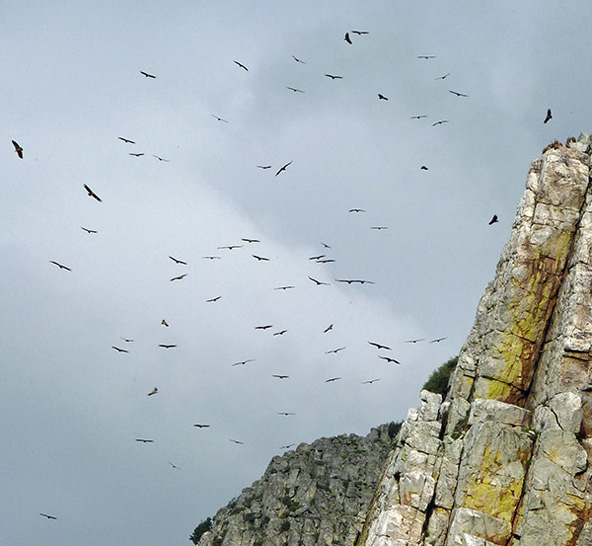 Griffon Vultures at Monfragüe
© John Muddeman
Griffon Vultures at Monfragüe
© John Muddeman
Happily in conservation terms, fate provided most of the region with rather poor soils overlying quick-draining sedimentary and metamorphic rocks. This led to the development and implementation of a unique farming system over huge areas able to exploit these difficult conditions through a 3 - 4 year rotational cycle of cropping, fallow and extensive grazing. In habitat terms this is known as dehesa (agricultural wood-pasture). The now treeless areas constitute the vast rolling agricultural pseudosteppe, which being largely non-irrigated and a patchwork of cropped, fallow and grazing lands, still retain impressive numbers of breeding Montagu's Harrier, Stone Curlew, Great and Little Bustards, Pin-tailed and Black-bellied Sandgrouse, Greater Short-toed, Calandra and Crested Larks, Spanish Sparrows and other open ground specialists, and serves as the foraging area for many of the raptors nesting in the nearby woodlands and mountains. This all forms a remarkable small-, medium- and large-scale mosaic, with patches of open steppe grading through scrub to the open park-like dehesa which covers vast areas, which when untouched turns into closed scrub on the rockier hillsides and flanking the valleys, allowing for an even wider variety of habitats and birds. 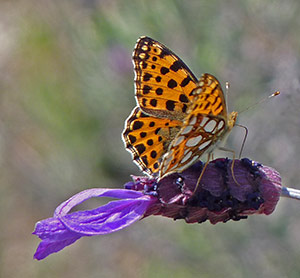 Queen-of-Spain Fritillary Issoria lathonia
© John Muddeman
Queen-of-Spain Fritillary Issoria lathonia
© John Muddeman
White Storks are just about everywhere, Black and Red Kites float low over the trees and roads searching for prey, rare Black-winged Kites hover as they hunt for voles, groups of quarrelsome Lesser Kestrels squabble on rooftops, wheezing Pallid Swifts whizz over the town squares, noisy Great Spotted Cuckoos hop through the flowers looking for hairy caterpillars before yelling at their hosts (the Common Magpies), flocks of marauding Iberian (Azure-winged) Magpies ghost through the dehesa, showy Woodchat Shrikes adorn the wires and bushes at almost every turn, smart Black-eared Wheatears perch perkily on fences and rock outcrops in the open fields and jingling Corn Buntings are found in their thousands. Are all characteristic birds here and still found in numbers very hard to beat elsewhere. Indeed, the first-time visitor is usually simply left amazed to see so many birds, even of common species, given the general declines observed in N Europe. Visits to specific sites are also included for scrub-dwellers such as Melodious, Western Orphean, Spectacled and Dartford Warblers, plus piratical Iberian Grey Shrike, glowing Eurasian Golden Orioles, shreeping Rock Sparrow and among select crags, the retiring Black Wheatear and colourful Rufous-tailed Rock Thrush amongst others. The flora of the dehesa is rather limited overall, but that said, with a remarkable species-richness at the small scale, being mostly comprised of large numbers of small annual grasses and flowers able to cope with the short spring flowering season. With rains lasting later into the spring, these can leave vast swathes of white, yellow and purple on the fields and plains.
The various wetlands in this apparently dry region are naturally highly attractive too, and though usually manmade, often make a welcome, albeit stark contrast to the drier plains. The smaller livestock drinking ponds attract passage waders such as Black-winged Stilt and Little Ringed Plover, as well as serving as drinking spots for sandgrouse, while the larger reservoirs, especially those with fringing reedmace or reeds, and even the wet areas associated with the abundant rice fields in the Guadiana catchment can simply be alive with birds. Western Marsh Harrier, Eurasian Spoonbill, Little Bittern, Squacco and Purple Herons, Great, Little and Cattle Egrets, Water Rail, Purple Swamphen, Cetti's, Great Reed and Savi's Warblers, Zitting Cisticola, Eurasian Penduline-tit, and the rather endearing introduced Red Avadavat and Common Waxbill may all be found.
The Sierra de Gredos close to the N provides a rather stark contrast. Peaking at over 2400m they form a natural barrier to the flow of cold air down from the N, so temperatures are much cooler, especially on the N slopes. Pyrenean Oak forests give way to mature Scot's Pine, then swathes of broom higher still until reaching barer grassy pastures and rocky outcrops around the highest peaks. The middle and upper slopes in particular provide home to suite of birds and other wildlife not found in the hotter conditions to the S, with key species here including Water Pipit, iberiae Yellow Wagtails, the endemic form of Bluethroat, Rufous-tailed Rock Thrush and Ortolan Bunting, while the rivers are home to White-throated Dipper and Eurasian Hobby, European Honey Buzzard, iberiae Pied Flycatcher, Firecrest and Citril Finch are at home in the pines. The Sierra de Gredos is also remarkable for the number of Spanish Ibex, allowing good viewing opportunities, and the large number of endemic forms of reptiles and amphibians present, from the showy Schreiber's Green and Iberian Rock Lizards, through the unusually dark almanzoris Fire Salamander and even local forms of Common Toad and Spanish Pond Frog! The tour will consequently also serve as an introduction to the reptiles, amphibians, butterflies, dragonflies and flora of the region as well, even though in May in the lowest areas the steppes will already be starting to turn brown and in wetter springs it can still be a bit slow for dragonflies then and potentially cold in the mountains! For a provisional itinerary, please see the Spainbirds page for this tour. -"I want to say a huge thank you for leading the trip so brilliantly. …as your ability to locate wildlife, your excellent driving and your enjoyable company. Having been on eight wildlife holidays now with various companies, I would have to say that your field skills are exceptional. For me, the highlights were the Black-shouldered Kites, the adult Spanish Imperial Eagle soaring near its nest site, the Bonelli's Eagles, the two Little Bustards chasing each other in flight, the Common Rock Thrushes …and of course, the three Otters. It really was a treat to watch so many raptors - you're very lucky to live in such a wonderful birding country. I really do hope to return before too long." Simon L. (UK) April 2013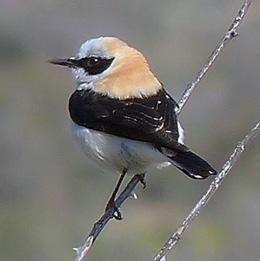 Black-eared Wheatear Oenanthe hispanica
© John Muddeman
Black-eared Wheatear Oenanthe hispanica
© John Muddeman
Extremadura and Gredos:
|
||||||||||||||||||||||||||||||||
| E-mail: | |
| Office phone: | (+34) 918 989195 |
| Mobile phone: | (+34) 649 608747 |
| Address: | C/ Alcocer 1, 1-C 28214 Fresnedillas de la Oliva, Madrid Spain |
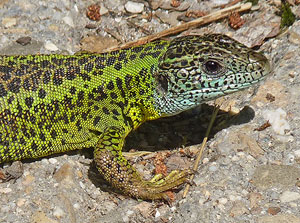 Schreiber's Green Lizard Lacerta schreiberi
© John Muddeman
Schreiber's Green Lizard Lacerta schreiberi
© John Muddeman
Other tours in Extremadura:
Coto Doñana & Extremadura: the best of SW Spain in spring!Extremadura: birds, wildlife and scenery galore
Related information:
Extremadura - birds and birdingComplete list of birds for Extremadura
Extremadura - location and geography
Complete list of butterflies for Extremadura
Blog entries on Extremadura birds, orchids and other wildlife
Read about John Muddeman
Wildlife holidays and natural history tours in Spain & Portugal
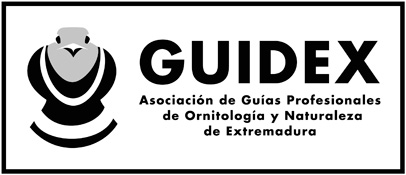 Accredited Birdwatching and Wildlife Guide in Extremadura
Accredited Birdwatching and Wildlife Guide in Extremadura
 |
|||
 |
|||
|


